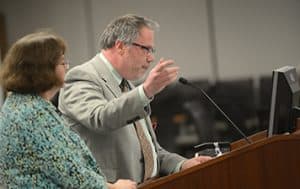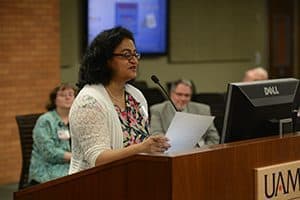Historical Research Center Celebrates Expansion, New Space
| May 12, 2016 | Unique artifacts such as a scrapbook of varnished tissue specimens along with historical documents such as a Civil War surgeon’s letters on the health of soldiers recently moved into newly renovated space at UAMS.
The Historical Research Center of the UAMS Library now includes a research room open to the public, the latest digital micrograph scanner and printer, and accessible space for archival materials. The center is the state’s premier repository for medical and health sciences history focused on Arkansas and is the official UAMS Archives. The renovation and expansion nearly doubles the previous center space.

Suzanne Easley, left, and Tim Nutt describe some of the artifacts and documents in the collection of the Historical Research Center.
The center reopening was celebrated May 9 with a reception and speakers. The program also served as the spring lecture for the Society for the History of Medicine and the Health Professions, which provides additional support for the research center.
UAMS Provost Stephanie Gardner, Ed. D., Pharm. D.; Nadia Lalla, associate provost for Library and Student Services; and Mary Ryan, president of the society, spoke on the significance of the renovations and the importance of the center. Keynote speakers Timothy G. Nutt, director of the Historical Research Center, and Suzanne Easley, the assistant director, focused on the history of the center and highlighted some of the collection’s items and materials.
“The documents and materials maintained by the center tell the story of this university,” Gardner said. “And due to the many Arkansas medical firsts that occurred here, it is also the story of medical history and health care in our state.”
She briefly recounted the story of a silver pitcher that belonged to Edwin Bentley, one of the founders of UAMS. The scorched and dented pitcher was discovered in the 1980s in a wooded area near Searcy. Ultimately, with the society’s help, the center acquired and restored it, and then gave the artifact a safe home in its collection.
“It is amazing how easily those historical treasures could have been lost,” Gardner said. “It also underscores the importance of the work done by UAMS archivists and historians to properly preserve our materials and artifacts so they may educate and inspire students, faculty, staff and visitors for generations to come.”
“The Historical Research Center is being propelled forward as a regional and national destination for scholars of all ages who want to research the history of medicine in Arkansas and the history of medicine in Arkansas life,” Lalla said. “We have a wealth of content of interest to ethnologists, sociologists, historians, economist, demographers, medical humanists, teachers and even high school students. It’s old stuff, but it’s not boring stuff.”
Following the remarks, Nutt and Easley described some of that “stuff” for the dozens of people gathered for the celebration. One of the artifacts they highlighted is the gold-handled cane of Augustus Breysacher, one of the eight founders of what became UAMS. One of Breysacher’s contemporaries, quoted by Easley, described Breysacher as a “gentleman of the old school” who was “very precise and deliberate in his personal habits. His tobacco spitting was the very quintessence of grace and accuracy. With geometrical precision, he could hit the exact center of each cuspidor as he strode up and down the aisles of the classroom delivering his lectures.”
Nutt showed the audience images of a small, trunk-like case outfitted with vents and features for carrying sick and premature babies to hospitals before there was any ambulance service in Little Rock. Other documents and objects in the presentation included photos from a midwives school for African-American women in the early 20th century and even some devices Nutt called artifacts of “quackery.”
After the reception, visitors were given formal tours of the center’s new location on the fifth floor of the library.

